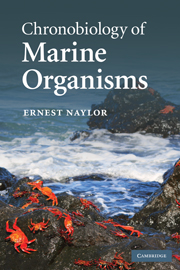Book contents
- Frontmatter
- Contents
- Preface
- 1 Moonshine
- 2 Biorhythms of coastal organisms
- 3 Tidal and daily time-cues
- 4 Clocks and compasses
- 5 Lunar and semilunar biorhythms
- 6 Annual biorhythms
- 7 Plankton vertical migration rhythms
- 8 Staying put in estuaries
- 9 Ocean drifters
- 10 Living clockwork
- References
- Author index
- Subject index
- Plate section
2 - Biorhythms of coastal organisms
Published online by Cambridge University Press: 05 June 2012
- Frontmatter
- Contents
- Preface
- 1 Moonshine
- 2 Biorhythms of coastal organisms
- 3 Tidal and daily time-cues
- 4 Clocks and compasses
- 5 Lunar and semilunar biorhythms
- 6 Annual biorhythms
- 7 Plankton vertical migration rhythms
- 8 Staying put in estuaries
- 9 Ocean drifters
- 10 Living clockwork
- References
- Author index
- Subject index
- Plate section
Summary
…whilst this planet has gone cycling on according to the fixed laws of gravity…endless forms most beautiful and most wonderful have been, and are being, evolved.
Charles Darwin, 1859Throughout Europe in the mid-nineteenth century there was intense scientific curiosity about the communities of animals and plants that were revealed by the rise and fall of tides along Atlantic coastlines. In Britain, Charles Darwin, Thomas Huxley and Philip Gosse were leading Victorian naturalists inspired to study that fauna and flora. Later in the nineteenth century, not content to merely observe, describe and classify living organisms in coastal seas, naturalists also saw the need to try to understand how they functioned and behaved. To achieve such objectives it was soon apparent that they would require facilities in which to maintain marine animals and plants under near-natural conditions in seawater aquarium systems. Cogent advocacy of their requirements, at a time of burgeoning public interest in marine life, then led to the establishment of specialist laboratories throughout the world in which detailed observations and experiments could be undertaken on a wide range of marine animals and plants (Ryland, 2000).
One such laboratory established by French biologists in 1872 was at Roscoff, in western France. There, on the beaches of Brittany, French and visiting biologists first recorded a striking rhythmic phenomenon, subsequent study of which proved to be seminal in the development of our understanding of biological clocks in marine animals and plants.
- Type
- Chapter
- Information
- Chronobiology of Marine Organisms , pp. 16 - 41Publisher: Cambridge University PressPrint publication year: 2010
- 1
- Cited by



